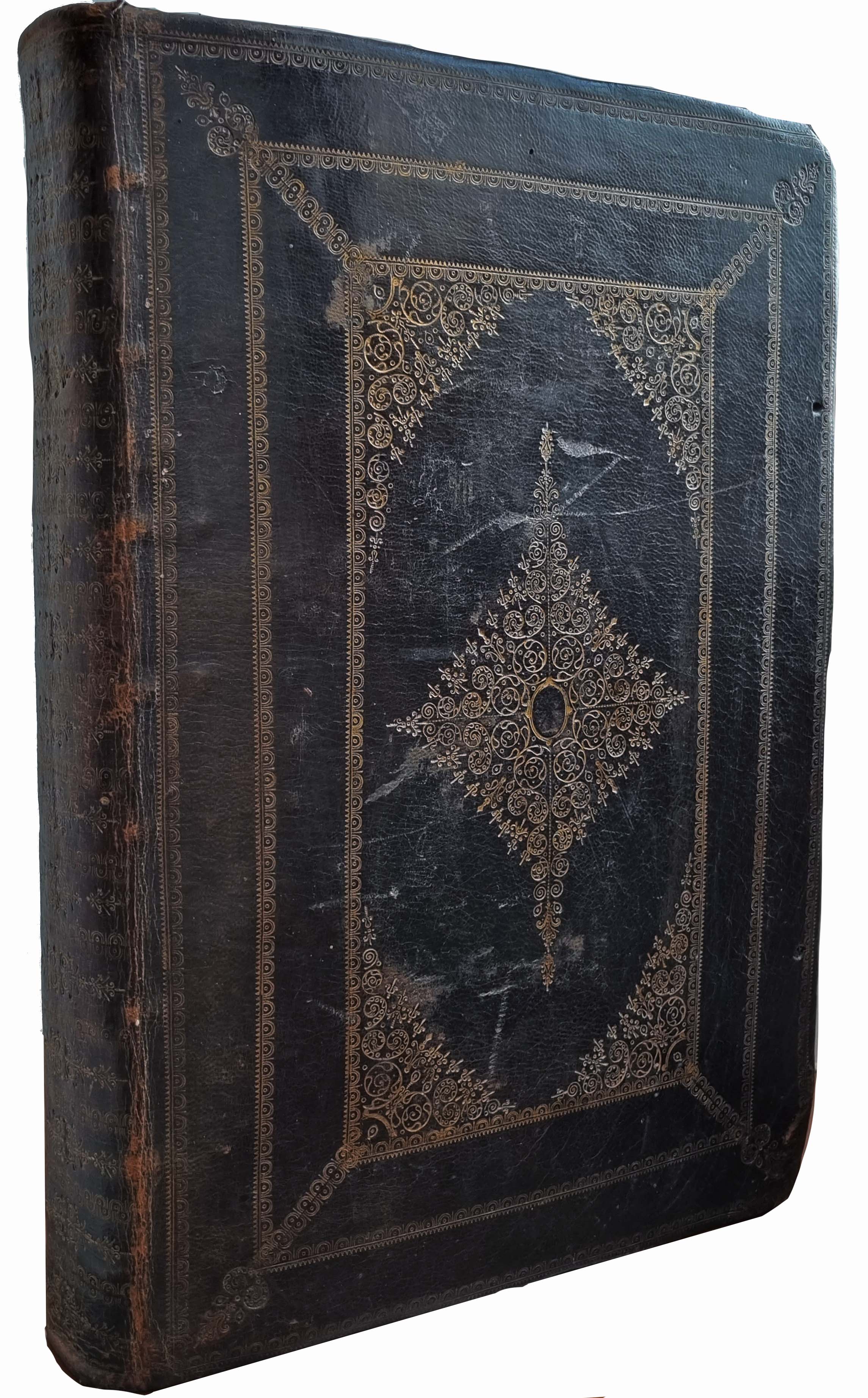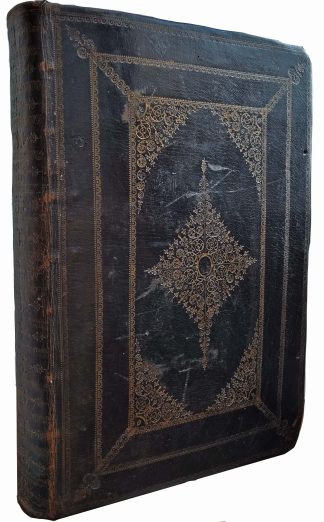BIBLE.
MONUMENTAL ENGLISH BINDING
The Holy Bible containing the Old Testament and the New. [with] The Whole Book of Psalmes.
[Cambridge], Printed by Tho. Buck and Roger Daniel, [1638].£12,500.00
Large folio. 3 parts in 1, separate titles, pp. [12], 642, 151, [1]; [2], 202; [9], 2-90, [5]. Roman letter, double column, all pages double ruled in red, woodcut notation to Part III. Title within handsome engraved border with Tetragrammaton, angels, biblical scenes, Moses, David, the Evangelists and the Last Supper, quadruple ruled in red, decorated initials and ornaments. Very light age yellowing, occasional slight marginal finger-soiling, couple of minor ancient repairs to blank margins, last verso dusty. An excellent, clean, well-margined copy in contemporary English black morocco, lacking ties, double gilt ruled with rolls of semicircles and dentelles, large gilt fleurons to corners, central panel with gilt pointillé arabesque cornerpieces of gouges and fleurons, similarly decorated gilt pointillé lozenge-shaped centrepiece, flat spine, gilt rolls of semicircles and fleurons, C18 marbled eps, a.e.g., joints and extremities a bit worn, a little scuffing to covers, ‘Judith Twisleton Book Octo 30th 1762’ to fly.
In a monumental, charmingly decorated black morocco binding, c.1640-50, probably from Cambridge. The gilt decoration is reminiscent of the style of the Cambridge binders John Houlden (1640s) and his son-in-law, Titus Tillet (fl. 1670s), who inherited his tools (Nixon & Foot, p.58, see pl.46, and BL c132i58), though we have not traced any exact matches for the pointillé tools, a style also found in London.
An excellent, well-margined copy of the standard King James Bible text until Paris’s Cambridge edition of 1762. ‘In this edition […] the work of correction begun in the folio Cambridge Bible of 1629 was carried further. The revisers took special pains to render uniform the use of italics; and they also introduced a certain number of new readings. […] Here occurs the famous reading in Acts vi.3, “…whom ye may appoint” (for “…whom we…”). This alteration has often been ascribed to the Puritans, and was reputed to have cost Cromwell a bribe of 1000l; yet here it is found as early as 1638, in a Bible prepared under the royal sanction’ (Darlow & Moule). This copy includes a 1638 Cambridge edition of the Book of Psalms, the first English translation, by Sternhold and Hopkins, first published in 1562 and considered the standard text for 200 years.
The Twisletons were a large and important family, connected, through marriage with the Fiennes in the 1670s, with the title Baron Saye and Sele. The Judith Twisleton who owned this copy, neé Boynton (1701-79), married John Twisleton of Horseman’s Place, Kent, in 1726. Her estate was claimed by Thomas Twisleton (b.1735), from the main branch of the family, who succeeded in obtaining the title in 1781. His daughter was the notorious Julia-Judith Twisleton (1771-1843), later married to James Henry Leigh, and mistress of Stoneleigh Abbey, Warwickshire. She was posthumously accused of committing several murders and even faking her husband’s funeral. The Leighs cum Twisletons were close friends of Jane Austen and her family, who spent time at Stoneleigh.
I: Only Huntington, HRC and Illinois copies recorded in the US. ESTC S694; STC (2nd ed.) 2331.3; Darlow & Moule 403. Not in Herbert. II: ESTC S122380; STC (2nd ed.), 2682. H.M. Nixon, M. Foot, The History of Decorated Bookbinding in England (1992).In stock





